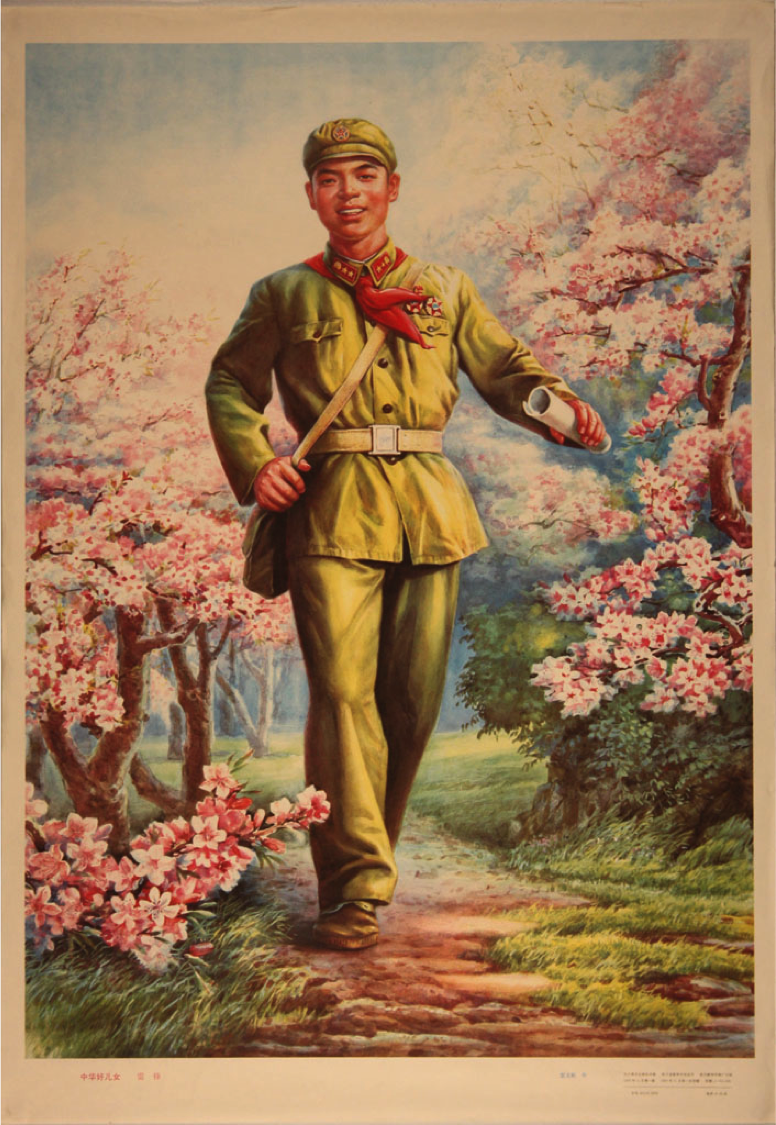China’s Good Kid – Lei Feng
Lei Wenbin雷文彬
Offset lithographic print, 1990
China’s Good Kid – Lei Feng: an essay
Tyler Finn
China’s Good Kid – Lei Feng, designed by Lei Wenbin (b. 1948), is an offset lithographic print that illuminates Lei Feng through use of vibrant colors and meticulous structure and symmetry. The pink flowers in the background coupled with the green grass and uniform of Lei Feng in the foreground creates a pleasing contrast that makes the individual components stand out while still maintaining the integrity of the image as a whole. What really is distinctive of the image is the natural symmetry seen in the image. Lei Feng is bordered by bright, beautiful pink flowers on either side as he strides down the middle of the path. The grass contributes to the symmetry of the image as the left and right side of the path contain similar colors and quantities. The symmetrical nature is naturally pleasing and Lei Wenbin exploited this strategy brilliantly. The red scarf shines brightly against the green uniform, which again creates a nice contrast that draws the eyes. Lei Feng is clearly the focal point as he is the center of the image.
The image depicts a young Lei Feng dressed in a standard People’s Liberation Army uniform gliding along on a path on an extremely beautiful day somewhere in China. Lei has a pack draped down his right side and is carrying papers in his left hand with a vibrant smile on his face. This image is a carefully crafted propaganda poster that is aimed directly at the young men of China. Lei Feng died in August of 1962, which was 28 years before the public saw this poster, but this young man had a transcendent aura about him that made him quite literally the poster child for the army. In the 1960’s, the Chinese exploited Lei Feng and made him out to be almost a mythical figure within the Chinese army. Even though he had died 28 years prior, his likeness was still being used to promote the army to young men. This image conveys the idea that being in the army is no more than a simple walk in the park while having the opportunity to see the most beautiful landscapes and sceneries in the country. The smile on his face coupled with his skipping gait expresses joy and freedom while completely leaving out any of the dark and haunting characteristics that might be present in a solder serving in a military capacity. The lavish light pink and deep green colors help suggest the ideas of comfort, trust, and innocence. A young man in China would have to be a fool to turn down being in the army if this image was a reflection of what it was like to really be a soldier.
This poster was created and deployed in 1990, which happens to be right after the incident in Tiananmen Square on June 4th of the previous year. Colloquially referred to as just “June Fourth,” this incident was the culmination of a long period of student protests taking place in Beijing. Demonstrations had started in the spring of 1989 after the death of former Communist Party General Secretary, Hu Yaobang. Hu had become the enemy of many party leaders with his radical economic and political reforms. He was forced to resign from his position as the general secretary of the party by the party elders. After his death, millions of students rallied and mourned his death. The students were also demonstrating for a more transparent government, just as Hu Yaobang had encouraged. The protesters cried out for freedom of speech, freedom of the press, and other limitations on the government. As these demonstrations were spreading throughout the city and gaining popularity, the government of China declared on May 20th that martial law was in effect. Martial law is when the military is authorized to enforce military rule on a temporary basis in a set location. With martial law in effect, the military was charged with forcefully bringing the demonstrations, which were happening throughout Beijing, to a halt. Starting on the night of June 3rd, the military began clearing the square by shooting and beating civilian protesters. Some estimate that soldiers killed nearly 6,000 civilians during this massacre. The image of Lei Feng happily striding along a path in a beautiful Chinese landscape does not seem to depict the dark side of the Chinese military that was tasked with killing innocent civilians in the spring of 1989. By the time that this image was seen by the public in 1990, the public’s perception of the Chinese Army was extremely negative. An image like this showing a hero, such as Lei Feng, could be utilized to try to sway young men away from the belief that the army was filled with murderers and cold-blooded criminals. The Chinese government, in an attempt to erase all memory of the bloody massacre, began releasing propaganda and censoring the event as much as possible. Lei Wenbin was born in 1948 which means that he grew up during the Cultural Revolution. Designing this joyful image of Lei Feng would have been natural as he was most likely drawing on his previous experiences of creating Lei Feng images in the 1960’s. Even though Lei Feng had died many years before this incident, he was still widely regarded as a national hero and an icon of the People’s Liberation Army. If there were any character capable of spreading positive Chinese Army propaganda in a time of distress, it was be Lei Feng.
Selected Bibliography
Naughton, Barry. The Chinese Economy: Transitions and Growth. Cambridge, MA: MIT, 2007. Print.
“The Tiananmen Papers.” Foreign Affairs. 1 Jan. 2001. Web. 8 Dec. 2013. <http://www.foreignaffairs.com/articles/56670/andrew-j-nathan/the-tiananmen-papers>.
